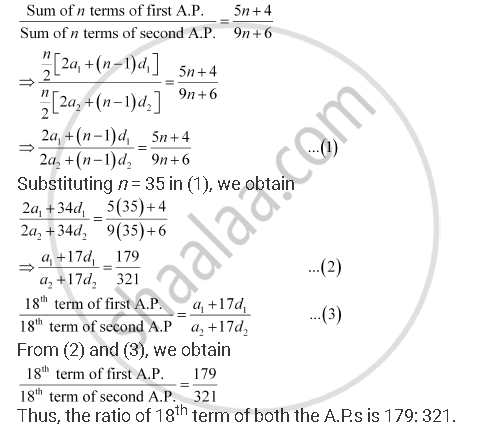Advertisements
Advertisements
Question
The sums of n terms of two arithmetic progressions are in the ratio 5n + 4: 9n + 6. Find the ratio of their 18th terms
Solution
Let a1, a2, and d1, d2 be the first terms and the common difference of the first and second arithmetic progression respectively.
According to the given condition,

APPEARS IN
RELATED QUESTIONS
Find the sum of all natural numbers lying between 100 and 1000, which are multiples of 5.
Find the sum of all two digit numbers which when divided by 4, yields 1 as remainder.
A manufacturer reckons that the value of a machine, which costs him Rs 15625, will depreciate each year by 20%. Find the estimated value at the end of 5 years.
Let < an > be a sequence. Write the first five term in the following:
a1 = 1, an = an − 1 + 2, n ≥ 2
Show that the following sequence is an A.P. Also find the common difference and write 3 more terms in case.
\[\sqrt{2}, 3\sqrt{2}, 5\sqrt{2}, 7\sqrt{2}, . . .\]
Which term of the A.P. 3, 8, 13, ... is 248?
Is 302 a term of the A.P. 3, 8, 13, ...?
Which term of the sequence 12 + 8i, 11 + 6i, 10 + 4i, ... is purely real ?
The 10th and 18th terms of an A.P. are 41 and 73 respectively. Find 26th term.
In a certain A.P. the 24th term is twice the 10th term. Prove that the 72nd term is twice the 34th term.
If the nth term of the A.P. 9, 7, 5, ... is same as the nth term of the A.P. 15, 12, 9, ... find n.
How many numbers are there between 1 and 1000 which when divided by 7 leave remainder 4?
If < an > is an A.P. such that \[\frac{a_4}{a_7} = \frac{2}{3}, \text { find }\frac{a_6}{a_8}\].
Find the sum of the following serie:
101 + 99 + 97 + ... + 47
Solve:
1 + 4 + 7 + 10 + ... + x = 590.
The first term of an A.P. is 2 and the last term is 50. The sum of all these terms is 442. Find the common difference.
The number of terms of an A.P. is even; the sum of odd terms is 24, of the even terms is 30, and the last term exceeds the first by \[10 \frac{1}{2}\] ,find the number of terms and the series.
In an A.P. the first term is 2 and the sum of the first five terms is one fourth of the next five terms. Show that 20th term is −112.
If \[\frac{b + c}{a}, \frac{c + a}{b}, \frac{a + b}{c}\] are in A.P., prove that:
bc, ca, ab are in A.P.
If a, b, c is in A.P., prove that:
(a − c)2 = 4 (a − b) (b − c)
A man saved Rs 16500 in ten years. In each year after the first he saved Rs 100 more than he did in the receding year. How much did he save in the first year?
A piece of equipment cost a certain factory Rs 600,000. If it depreciates in value, 15% the first, 13.5% the next year, 12% the third year, and so on. What will be its value at the end of 10 years, all percentages applying to the original cost?
A man is employed to count Rs 10710. He counts at the rate of Rs 180 per minute for half an hour. After this he counts at the rate of Rs 3 less every minute than the preceding minute. Find the time taken by him to count the entire amount.
In a potato race 20 potatoes are placed in a line at intervals of 4 meters with the first potato 24 metres from the starting point. A contestant is required to bring the potatoes back to the starting place one at a time. How far would he run in bringing back all the potatoes?
In n A.M.'s are introduced between 3 and 17 such that the ratio of the last mean to the first mean is 3 : 1, then the value of n is
If Sn denotes the sum of first n terms of an A.P. < an > such that
If the sum of n terms of an A.P., is 3 n2 + 5 n then which of its terms is 164?
If the first, second and last term of an A.P are a, b and 2a respectively, then its sum is
Write the quadratic equation the arithmetic and geometric means of whose roots are Aand G respectively.
If for an arithmetic progression, 9 times nineth term is equal to 13 times thirteenth term, then value of twenty second term is ____________.
The first term of an A.P. is a, the second term is b and the last term is c. Show that the sum of the A.P. is `((b + c - 2a)(c + a))/(2(b - a))`.
Find the sum of first 24 terms of the A.P. a1, a2, a3, ... if it is known that a1 + a5 + a10 + a15 + a20 + a24 = 225.
Show that (x2 + xy + y2), (z2 + xz + x2) and (y2 + yz + z2) are consecutive terms of an A.P., if x, y and z are in A.P.
If the sum of n terms of an A.P. is given by Sn = 3n + 2n2, then the common difference of the A.P. is ______.
The internal angles of a convex polygon are in A.P. The smallest angle is 120° and the common difference is 5°. The number to sides of the polygon is ______.
